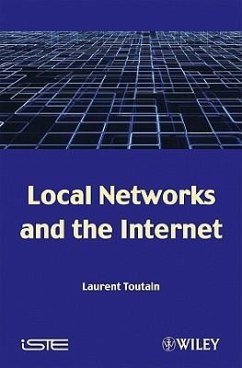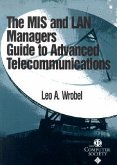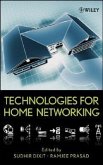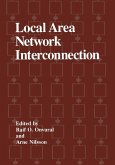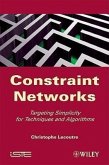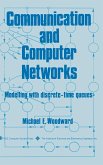- Gebundenes Buch
- Merkliste
- Auf die Merkliste
- Bewerten Bewerten
- Teilen
- Produkt teilen
- Produkterinnerung
- Produkterinnerung
This title covers the most commonly used elements of Internet and Intranet technology and their development. It details the latest developments in research and covers new themes such as IP6, MPLS, and IS-IS routing, as well as explaining the function of standardization committees such as IETF, IEEE, and UIT. The book is illustrated with numerous examples and applications which will help the reader to place protocols in their proper context.
Andere Kunden interessierten sich auch für
![MIS and LAN Manager's Guide to Advanced Telecommunications MIS and LAN Manager's Guide to Advanced Telecommunications]() Leo A WrobelMIS and LAN Manager's Guide to Advanced Telecommunications129,99 €
Leo A WrobelMIS and LAN Manager's Guide to Advanced Telecommunications129,99 €![Technologies for Home Networking Technologies for Home Networking]() Technologies for Home Networking125,99 €
Technologies for Home Networking125,99 €![Local Area Network Interconnection Local Area Network Interconnection]() International Conference on Local Area Network InterconnectionLocal Area Network Interconnection60,99 €
International Conference on Local Area Network InterconnectionLocal Area Network Interconnection60,99 €![Constraint Networks Constraint Networks]() Christophe LecoutreConstraint Networks305,99 €
Christophe LecoutreConstraint Networks305,99 €![Communication and Computer Networks Communication and Computer Networks]() Michael E WoodwardCommunication and Computer Networks93,99 €
Michael E WoodwardCommunication and Computer Networks93,99 €![Service Efficient Network Interconnection Via Satellite Service Efficient Network Interconnection Via Satellite]() Y. Fun Hu / Gérard Maral / Erina Ferro (Hgg.)Service Efficient Network Interconnection Via Satellite259,99 €
Y. Fun Hu / Gérard Maral / Erina Ferro (Hgg.)Service Efficient Network Interconnection Via Satellite259,99 €![Mobility Models for Next Generation Wireless Networks Mobility Models for Next Generation Wireless Networks]() Paolo SantiMobility Models for Next Generation Wireless Networks114,99 €
Paolo SantiMobility Models for Next Generation Wireless Networks114,99 €-
-
-
This title covers the most commonly used elements of Internet and Intranet technology and their development. It details the latest developments in research and covers new themes such as IP6, MPLS, and IS-IS routing, as well as explaining the function of standardization committees such as IETF, IEEE, and UIT. The book is illustrated with numerous examples and applications which will help the reader to place protocols in their proper context.
Produktdetails
- Produktdetails
- Verlag: Wiley
- Seitenzahl: 689
- Erscheinungstermin: 15. Februar 2011
- Englisch
- Abmessung: 234mm x 157mm x 43mm
- Gewicht: 1139g
- ISBN-13: 9781848210684
- ISBN-10: 184821068X
- Artikelnr.: 30968376
- Herstellerkennzeichnung
- Libri GmbH
- Europaallee 1
- 36244 Bad Hersfeld
- gpsr@libri.de
- Verlag: Wiley
- Seitenzahl: 689
- Erscheinungstermin: 15. Februar 2011
- Englisch
- Abmessung: 234mm x 157mm x 43mm
- Gewicht: 1139g
- ISBN-13: 9781848210684
- ISBN-10: 184821068X
- Artikelnr.: 30968376
- Herstellerkennzeichnung
- Libri GmbH
- Europaallee 1
- 36244 Bad Hersfeld
- gpsr@libri.de
Laurent Toutain is the author of Local Networks and the Internet: From Protocols to Interconnection, published by Wiley. Ana Minaburo is the author of Local Networks and the Internet: From Protocols to Interconnection, published by Wiley.
Chapter 1. Introduction 1
1.1. Why a network? 1
1.2. Network classification 2
1.3. Interconnection networks. 8
1.4. Examples of network utilization 10
1.5. The Internet network 11
1.6. Structure of this book 15
Chapter 2. Standardization and Wiring 19
2.1. The IEEE 802 committee 19
2.2. The standards 21
2.3. IEEE 802.1 addressing 27
2.4. Cabling rules 30
Chapter 3. Ethernet and IEEE 802.3 Protocols 37
3.1. History 37
3.2. Physical level 39
3.3. The fundamentals of CSMA/CD 45
3.4. Frame format 53
3.5. The 10BASE5 network 58
3.6. Devices for the 10BASE2 62
3.7. Twisted pair equipment 63
3.8. Fiber optics 79
3.9. Examples of Ethernet frames 87
3.10 Evolution of the Ethernet 92
Chapter 4. The LLC and SNAP Sublayers 95
4.1. Definition 95
4.2. LLC frames 97
4.3. Example 106
4.4. The SNAP layer 111
Chapter 5. Interconnection by Bridges: The Spanning Tree Algorithm 115
5.1. Introduction115
5.2. Transparent filtering bridges 116
5.3. Spanning tree algorithm 118
Chapter 6. Internet 131
6.1. The Internet players 131
Chapter 7. IP Protocols 143
7.1. Implementation of the TCP/IP protocols 143
7.2. Internet addressing 149
7.3. The IPv4 protocol (RFC 791, RFC 1122) 168
7.4. The ICMP (Internet Control Message Protocol) (RFC 792) 180
7.5. The IPv6 protocol 196
7.6. Tunnels 199
7.7. Configurations 202
7.8. Configuration of a Cisco router 204
7.9. IPv4 and multicast 207
Chapter 8. Level 4 Protocols: TCP, UDP and SCTP 213
8.1. Port notion 213
8.2. TCP (Transmission Control Protocol) (RFC 793) 215
8.3. The three protocol phases 218
8.4. The options 227
8.5. Adaptation to the environment 230
8.6. TCP flow control 239
8.7. Study of TCP by simulations 252
8.8. Network consideration of TCP 263
8.9. The UDP (user datagram protocol) (RFC 768) 275
8.10. SCTP 283
Chapter 9. Address Resolution and Automatic Configuration Protocols 299
9.1. Introduction 299
9.2. The address resolution protocol (ARP) 300
9.3. Neighbor discovery in IPv6 308
9.4. Initialization and auto-configuration 309
9.5. The domain name server (DNS) (RFC 1034, RFC 1035) 333
Chapter 10. Routing Protocols 367
10.1. Routing tables 367
10.2. Equipment classification 368
10.3. Routing table configuration 369
10.4. Station or router? 373
10.5. High-speed router 374
10.6. Router classification 375
10.7. Routing protocols 376
10.8. Autonomous systems 376
Chapter 11. Internal Routing Protocols 381
11.1. The Distant Vector algorithm 381
11.2. Link State algorithm 396
11.3. The OSPF protocol 403
11.4. IS-IS 434
Chapter 12. External Routing Protocols 453
12.1. Path announcing 453
12.2. The interconnection points 461
12.3. The symmetry of routes 461
12.4. BGP (border gateway protocol) 462
12.5. Route selection rules 480
12.6. BGP traffic analysis 481
12.7. Reduction of oscillations 485
12.8. Routing limit in the Internet 486
Chapter 13. Virtual Local Networks 487
13.1. Definition 487
13.2. Multicast data management 488
13.3. Virtual networks 497
Chapter 14. MPLS (Multi Protocol Label Switching) 507
14.1. Routing protocols' limits 507
14.2. MPLS header format 510
14.3. Principles of operation 513
14.4. MPLS label D distribution protocols 518
14.5. Traffic engineering 525
Chapter 15. IP on Point-to-Point Links: PPP 529
15.1. Serial links 530
15.2. SLIP (Serial Link IP, RFC 1055) 533
15.3. PPP (point-to-point protocol, RFC 1661) 535
15.4. Configuration of routers 560
15.5. The RADIUS protocol 560
15.6. PPP over X.25 (RFC 1598) 561
15.7. PPP over high-speed networks 561
15.8. Bridging with PPP (RFC 1638) 561
15.9. ADSL network architecture 565
Chapter 16. Network Administration 571
16.1. Vocabulary and concepts 571
16.2. ASN.1 (Abstract Syntax Notation) 574
16.3. Definition of the MIB SNMP (RFC 1213) 579
16.4. Format of SNMPvl messages (RFC 1157) 581
16.5. Formats of SNMPv2 messages (RFC 1905) 587
16.6. Examples of SNMPvl traffic 590
16.7. MIB example 594
16.8. Other MIBs 607
Chapter 17. Security 613
17.1. Risks 613
17.2. Filtering routers 614
17.3. Bastion 622
17.4. Proxy 623
17.5. NAT (Network Address Translator, RFC 1631) 624
Chapter 18. Flow Management 627
18.1. Quality of service 627
18.2. Flow notion 630
18.3. Flow management 631
18.4. Flow measurements 644
18.5. Integration of services on the Internet 648
18.6. Differentiated services 675
18.7. Perspectives 677
Bibliography 679
Index 681
1.1. Why a network? 1
1.2. Network classification 2
1.3. Interconnection networks. 8
1.4. Examples of network utilization 10
1.5. The Internet network 11
1.6. Structure of this book 15
Chapter 2. Standardization and Wiring 19
2.1. The IEEE 802 committee 19
2.2. The standards 21
2.3. IEEE 802.1 addressing 27
2.4. Cabling rules 30
Chapter 3. Ethernet and IEEE 802.3 Protocols 37
3.1. History 37
3.2. Physical level 39
3.3. The fundamentals of CSMA/CD 45
3.4. Frame format 53
3.5. The 10BASE5 network 58
3.6. Devices for the 10BASE2 62
3.7. Twisted pair equipment 63
3.8. Fiber optics 79
3.9. Examples of Ethernet frames 87
3.10 Evolution of the Ethernet 92
Chapter 4. The LLC and SNAP Sublayers 95
4.1. Definition 95
4.2. LLC frames 97
4.3. Example 106
4.4. The SNAP layer 111
Chapter 5. Interconnection by Bridges: The Spanning Tree Algorithm 115
5.1. Introduction115
5.2. Transparent filtering bridges 116
5.3. Spanning tree algorithm 118
Chapter 6. Internet 131
6.1. The Internet players 131
Chapter 7. IP Protocols 143
7.1. Implementation of the TCP/IP protocols 143
7.2. Internet addressing 149
7.3. The IPv4 protocol (RFC 791, RFC 1122) 168
7.4. The ICMP (Internet Control Message Protocol) (RFC 792) 180
7.5. The IPv6 protocol 196
7.6. Tunnels 199
7.7. Configurations 202
7.8. Configuration of a Cisco router 204
7.9. IPv4 and multicast 207
Chapter 8. Level 4 Protocols: TCP, UDP and SCTP 213
8.1. Port notion 213
8.2. TCP (Transmission Control Protocol) (RFC 793) 215
8.3. The three protocol phases 218
8.4. The options 227
8.5. Adaptation to the environment 230
8.6. TCP flow control 239
8.7. Study of TCP by simulations 252
8.8. Network consideration of TCP 263
8.9. The UDP (user datagram protocol) (RFC 768) 275
8.10. SCTP 283
Chapter 9. Address Resolution and Automatic Configuration Protocols 299
9.1. Introduction 299
9.2. The address resolution protocol (ARP) 300
9.3. Neighbor discovery in IPv6 308
9.4. Initialization and auto-configuration 309
9.5. The domain name server (DNS) (RFC 1034, RFC 1035) 333
Chapter 10. Routing Protocols 367
10.1. Routing tables 367
10.2. Equipment classification 368
10.3. Routing table configuration 369
10.4. Station or router? 373
10.5. High-speed router 374
10.6. Router classification 375
10.7. Routing protocols 376
10.8. Autonomous systems 376
Chapter 11. Internal Routing Protocols 381
11.1. The Distant Vector algorithm 381
11.2. Link State algorithm 396
11.3. The OSPF protocol 403
11.4. IS-IS 434
Chapter 12. External Routing Protocols 453
12.1. Path announcing 453
12.2. The interconnection points 461
12.3. The symmetry of routes 461
12.4. BGP (border gateway protocol) 462
12.5. Route selection rules 480
12.6. BGP traffic analysis 481
12.7. Reduction of oscillations 485
12.8. Routing limit in the Internet 486
Chapter 13. Virtual Local Networks 487
13.1. Definition 487
13.2. Multicast data management 488
13.3. Virtual networks 497
Chapter 14. MPLS (Multi Protocol Label Switching) 507
14.1. Routing protocols' limits 507
14.2. MPLS header format 510
14.3. Principles of operation 513
14.4. MPLS label D distribution protocols 518
14.5. Traffic engineering 525
Chapter 15. IP on Point-to-Point Links: PPP 529
15.1. Serial links 530
15.2. SLIP (Serial Link IP, RFC 1055) 533
15.3. PPP (point-to-point protocol, RFC 1661) 535
15.4. Configuration of routers 560
15.5. The RADIUS protocol 560
15.6. PPP over X.25 (RFC 1598) 561
15.7. PPP over high-speed networks 561
15.8. Bridging with PPP (RFC 1638) 561
15.9. ADSL network architecture 565
Chapter 16. Network Administration 571
16.1. Vocabulary and concepts 571
16.2. ASN.1 (Abstract Syntax Notation) 574
16.3. Definition of the MIB SNMP (RFC 1213) 579
16.4. Format of SNMPvl messages (RFC 1157) 581
16.5. Formats of SNMPv2 messages (RFC 1905) 587
16.6. Examples of SNMPvl traffic 590
16.7. MIB example 594
16.8. Other MIBs 607
Chapter 17. Security 613
17.1. Risks 613
17.2. Filtering routers 614
17.3. Bastion 622
17.4. Proxy 623
17.5. NAT (Network Address Translator, RFC 1631) 624
Chapter 18. Flow Management 627
18.1. Quality of service 627
18.2. Flow notion 630
18.3. Flow management 631
18.4. Flow measurements 644
18.5. Integration of services on the Internet 648
18.6. Differentiated services 675
18.7. Perspectives 677
Bibliography 679
Index 681
Chapter 1. Introduction 1
1.1. Why a network? 1
1.2. Network classification 2
1.3. Interconnection networks. 8
1.4. Examples of network utilization 10
1.5. The Internet network 11
1.6. Structure of this book 15
Chapter 2. Standardization and Wiring 19
2.1. The IEEE 802 committee 19
2.2. The standards 21
2.3. IEEE 802.1 addressing 27
2.4. Cabling rules 30
Chapter 3. Ethernet and IEEE 802.3 Protocols 37
3.1. History 37
3.2. Physical level 39
3.3. The fundamentals of CSMA/CD 45
3.4. Frame format 53
3.5. The 10BASE5 network 58
3.6. Devices for the 10BASE2 62
3.7. Twisted pair equipment 63
3.8. Fiber optics 79
3.9. Examples of Ethernet frames 87
3.10 Evolution of the Ethernet 92
Chapter 4. The LLC and SNAP Sublayers 95
4.1. Definition 95
4.2. LLC frames 97
4.3. Example 106
4.4. The SNAP layer 111
Chapter 5. Interconnection by Bridges: The Spanning Tree Algorithm 115
5.1. Introduction115
5.2. Transparent filtering bridges 116
5.3. Spanning tree algorithm 118
Chapter 6. Internet 131
6.1. The Internet players 131
Chapter 7. IP Protocols 143
7.1. Implementation of the TCP/IP protocols 143
7.2. Internet addressing 149
7.3. The IPv4 protocol (RFC 791, RFC 1122) 168
7.4. The ICMP (Internet Control Message Protocol) (RFC 792) 180
7.5. The IPv6 protocol 196
7.6. Tunnels 199
7.7. Configurations 202
7.8. Configuration of a Cisco router 204
7.9. IPv4 and multicast 207
Chapter 8. Level 4 Protocols: TCP, UDP and SCTP 213
8.1. Port notion 213
8.2. TCP (Transmission Control Protocol) (RFC 793) 215
8.3. The three protocol phases 218
8.4. The options 227
8.5. Adaptation to the environment 230
8.6. TCP flow control 239
8.7. Study of TCP by simulations 252
8.8. Network consideration of TCP 263
8.9. The UDP (user datagram protocol) (RFC 768) 275
8.10. SCTP 283
Chapter 9. Address Resolution and Automatic Configuration Protocols 299
9.1. Introduction 299
9.2. The address resolution protocol (ARP) 300
9.3. Neighbor discovery in IPv6 308
9.4. Initialization and auto-configuration 309
9.5. The domain name server (DNS) (RFC 1034, RFC 1035) 333
Chapter 10. Routing Protocols 367
10.1. Routing tables 367
10.2. Equipment classification 368
10.3. Routing table configuration 369
10.4. Station or router? 373
10.5. High-speed router 374
10.6. Router classification 375
10.7. Routing protocols 376
10.8. Autonomous systems 376
Chapter 11. Internal Routing Protocols 381
11.1. The Distant Vector algorithm 381
11.2. Link State algorithm 396
11.3. The OSPF protocol 403
11.4. IS-IS 434
Chapter 12. External Routing Protocols 453
12.1. Path announcing 453
12.2. The interconnection points 461
12.3. The symmetry of routes 461
12.4. BGP (border gateway protocol) 462
12.5. Route selection rules 480
12.6. BGP traffic analysis 481
12.7. Reduction of oscillations 485
12.8. Routing limit in the Internet 486
Chapter 13. Virtual Local Networks 487
13.1. Definition 487
13.2. Multicast data management 488
13.3. Virtual networks 497
Chapter 14. MPLS (Multi Protocol Label Switching) 507
14.1. Routing protocols' limits 507
14.2. MPLS header format 510
14.3. Principles of operation 513
14.4. MPLS label D distribution protocols 518
14.5. Traffic engineering 525
Chapter 15. IP on Point-to-Point Links: PPP 529
15.1. Serial links 530
15.2. SLIP (Serial Link IP, RFC 1055) 533
15.3. PPP (point-to-point protocol, RFC 1661) 535
15.4. Configuration of routers 560
15.5. The RADIUS protocol 560
15.6. PPP over X.25 (RFC 1598) 561
15.7. PPP over high-speed networks 561
15.8. Bridging with PPP (RFC 1638) 561
15.9. ADSL network architecture 565
Chapter 16. Network Administration 571
16.1. Vocabulary and concepts 571
16.2. ASN.1 (Abstract Syntax Notation) 574
16.3. Definition of the MIB SNMP (RFC 1213) 579
16.4. Format of SNMPvl messages (RFC 1157) 581
16.5. Formats of SNMPv2 messages (RFC 1905) 587
16.6. Examples of SNMPvl traffic 590
16.7. MIB example 594
16.8. Other MIBs 607
Chapter 17. Security 613
17.1. Risks 613
17.2. Filtering routers 614
17.3. Bastion 622
17.4. Proxy 623
17.5. NAT (Network Address Translator, RFC 1631) 624
Chapter 18. Flow Management 627
18.1. Quality of service 627
18.2. Flow notion 630
18.3. Flow management 631
18.4. Flow measurements 644
18.5. Integration of services on the Internet 648
18.6. Differentiated services 675
18.7. Perspectives 677
Bibliography 679
Index 681
1.1. Why a network? 1
1.2. Network classification 2
1.3. Interconnection networks. 8
1.4. Examples of network utilization 10
1.5. The Internet network 11
1.6. Structure of this book 15
Chapter 2. Standardization and Wiring 19
2.1. The IEEE 802 committee 19
2.2. The standards 21
2.3. IEEE 802.1 addressing 27
2.4. Cabling rules 30
Chapter 3. Ethernet and IEEE 802.3 Protocols 37
3.1. History 37
3.2. Physical level 39
3.3. The fundamentals of CSMA/CD 45
3.4. Frame format 53
3.5. The 10BASE5 network 58
3.6. Devices for the 10BASE2 62
3.7. Twisted pair equipment 63
3.8. Fiber optics 79
3.9. Examples of Ethernet frames 87
3.10 Evolution of the Ethernet 92
Chapter 4. The LLC and SNAP Sublayers 95
4.1. Definition 95
4.2. LLC frames 97
4.3. Example 106
4.4. The SNAP layer 111
Chapter 5. Interconnection by Bridges: The Spanning Tree Algorithm 115
5.1. Introduction115
5.2. Transparent filtering bridges 116
5.3. Spanning tree algorithm 118
Chapter 6. Internet 131
6.1. The Internet players 131
Chapter 7. IP Protocols 143
7.1. Implementation of the TCP/IP protocols 143
7.2. Internet addressing 149
7.3. The IPv4 protocol (RFC 791, RFC 1122) 168
7.4. The ICMP (Internet Control Message Protocol) (RFC 792) 180
7.5. The IPv6 protocol 196
7.6. Tunnels 199
7.7. Configurations 202
7.8. Configuration of a Cisco router 204
7.9. IPv4 and multicast 207
Chapter 8. Level 4 Protocols: TCP, UDP and SCTP 213
8.1. Port notion 213
8.2. TCP (Transmission Control Protocol) (RFC 793) 215
8.3. The three protocol phases 218
8.4. The options 227
8.5. Adaptation to the environment 230
8.6. TCP flow control 239
8.7. Study of TCP by simulations 252
8.8. Network consideration of TCP 263
8.9. The UDP (user datagram protocol) (RFC 768) 275
8.10. SCTP 283
Chapter 9. Address Resolution and Automatic Configuration Protocols 299
9.1. Introduction 299
9.2. The address resolution protocol (ARP) 300
9.3. Neighbor discovery in IPv6 308
9.4. Initialization and auto-configuration 309
9.5. The domain name server (DNS) (RFC 1034, RFC 1035) 333
Chapter 10. Routing Protocols 367
10.1. Routing tables 367
10.2. Equipment classification 368
10.3. Routing table configuration 369
10.4. Station or router? 373
10.5. High-speed router 374
10.6. Router classification 375
10.7. Routing protocols 376
10.8. Autonomous systems 376
Chapter 11. Internal Routing Protocols 381
11.1. The Distant Vector algorithm 381
11.2. Link State algorithm 396
11.3. The OSPF protocol 403
11.4. IS-IS 434
Chapter 12. External Routing Protocols 453
12.1. Path announcing 453
12.2. The interconnection points 461
12.3. The symmetry of routes 461
12.4. BGP (border gateway protocol) 462
12.5. Route selection rules 480
12.6. BGP traffic analysis 481
12.7. Reduction of oscillations 485
12.8. Routing limit in the Internet 486
Chapter 13. Virtual Local Networks 487
13.1. Definition 487
13.2. Multicast data management 488
13.3. Virtual networks 497
Chapter 14. MPLS (Multi Protocol Label Switching) 507
14.1. Routing protocols' limits 507
14.2. MPLS header format 510
14.3. Principles of operation 513
14.4. MPLS label D distribution protocols 518
14.5. Traffic engineering 525
Chapter 15. IP on Point-to-Point Links: PPP 529
15.1. Serial links 530
15.2. SLIP (Serial Link IP, RFC 1055) 533
15.3. PPP (point-to-point protocol, RFC 1661) 535
15.4. Configuration of routers 560
15.5. The RADIUS protocol 560
15.6. PPP over X.25 (RFC 1598) 561
15.7. PPP over high-speed networks 561
15.8. Bridging with PPP (RFC 1638) 561
15.9. ADSL network architecture 565
Chapter 16. Network Administration 571
16.1. Vocabulary and concepts 571
16.2. ASN.1 (Abstract Syntax Notation) 574
16.3. Definition of the MIB SNMP (RFC 1213) 579
16.4. Format of SNMPvl messages (RFC 1157) 581
16.5. Formats of SNMPv2 messages (RFC 1905) 587
16.6. Examples of SNMPvl traffic 590
16.7. MIB example 594
16.8. Other MIBs 607
Chapter 17. Security 613
17.1. Risks 613
17.2. Filtering routers 614
17.3. Bastion 622
17.4. Proxy 623
17.5. NAT (Network Address Translator, RFC 1631) 624
Chapter 18. Flow Management 627
18.1. Quality of service 627
18.2. Flow notion 630
18.3. Flow management 631
18.4. Flow measurements 644
18.5. Integration of services on the Internet 648
18.6. Differentiated services 675
18.7. Perspectives 677
Bibliography 679
Index 681

